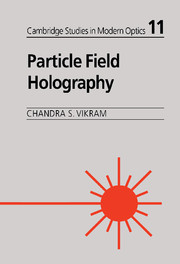Book contents
- Frontmatter
- Contents
- Foreword
- Preface
- Acknowledgements
- 1 Historical background
- 2 Introduction to holography
- 3 General theory of in-line Fraunhofer holography
- 4 System design considerations
- 5 Practical considerations
- 6 Analysis of reconstruction
- 7 Aberrations and their control
- 8 Hologram fringe-contrast and its enhancement
- 9 Non-image plane analysis
- 10 Velocimetry and high speed holography
- 11 The off-axis approach
- References
- Index
1 - Historical background
Published online by Cambridge University Press: 13 October 2009
- Frontmatter
- Contents
- Foreword
- Preface
- Acknowledgements
- 1 Historical background
- 2 Introduction to holography
- 3 General theory of in-line Fraunhofer holography
- 4 System design considerations
- 5 Practical considerations
- 6 Analysis of reconstruction
- 7 Aberrations and their control
- 8 Hologram fringe-contrast and its enhancement
- 9 Non-image plane analysis
- 10 Velocimetry and high speed holography
- 11 The off-axis approach
- References
- Index
Summary
There are a large number of situations in modern science and technology requiring the study of very small objects in a volume. These small objects, for example, could be fog, sprays, dust particles, burning coal particles, cavitation and other bubbles in water, fuel droplets in a combustion chamber, etc. In practical situations these objects are small and micrometer order resolution is often required. This resolution itself is not a problem with conventional microscopic techniques. However, a serious problem arises due to the need to study a dynamic volume and not just a plane. An imaging system that can resolve a diameter d has a depth of field of only about d2/λ, where λ is the wavelength of the light used. For d = 10 μm, λ = 0.5 μm, the depth of field is only 0.2 mm! Clearly this is not satisfactory.
Light scattering and diffraction methods depend on models. These models are often based on assumptions of the object shape, pre-knowledge of the refractive index and other physical parameters. These assumptions are good enough when rapid and mean particle size distribution rather than exact shape and other parameters are needed. An example is size distribution measurements in the ceramic industry. These methods being real-time in nature, are very valuable in particular situations. Some of these methods are described in Chapter 9.
These non-imaging methods are not adequate in a large number of situations of practical interest.
- Type
- Chapter
- Information
- Particle Field Holography , pp. 1 - 5Publisher: Cambridge University PressPrint publication year: 1992



